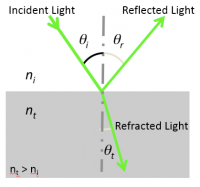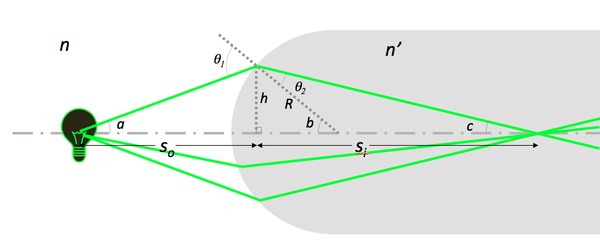Difference between revisions of "Geometrical optics and ray tracing"
From Course Wiki
MAXINE JONAS (Talk | contribs) (Created page with "Category:20.309 Category:Optical Microscopy Lab {{Template:20.309}} ==Refraction and reflection at a boundary== * The Snell-Descartes law or law of refraction stipulate...") |
MAXINE JONAS (Talk | contribs) |
||
| Line 3: | Line 3: | ||
{{Template:20.309}} | {{Template:20.309}} | ||
| − | ==Refraction and reflection at a boundary== | + | ==Refraction and reflection== |
| + | |||
| + | [[File: 20.309 130819 Snell.png|right|thumb|200px]] | ||
| + | ===Refraction and reflection at a boundary=== | ||
* The Snell-Descartes law or law of refraction stipulates that | * The Snell-Descartes law or law of refraction stipulates that | ||
| − | : | + | :<math> n_i\ \sin \theta_i = n_t\ \sin \theta_t </math> |
| + | :with <i>θ</i> the angle measured from the normal of the boundary, <math>n</math> the refractive index (which is unitless) of the medium, the subscripts <math>i</math> and <math>t</math> referring to the incident and transmitted light, respectively. | ||
| + | * The law of reflection states that <i>θ<sub>i</sub></i> = <i>θ<sub>r</sub></i> | ||
| + | |||
| + | |||
| + | ===Refraction and reflection at a spherical interface=== | ||
| + | |||
| + | [[Image: 20.309 130819 RefractionAtSphere.png|center|thumb|600px]] | ||
| + | With the assumptions: | ||
| + | * Paraxial approximation: θ ≈ sin θ ≈ tan θ | ||
| + | * Thin lens approximation: <math>R << S_o,\ S_i </math> | ||
| + | Snell's law predicts that | ||
| + | :<math> n\ \sin \theta_1 = n'\ \sin \theta_2 </math> | ||
| + | :<math> \sin \theta_1 \approx \sin a + \sin b \approx {h \over S_o} + {h \over R} </math> | ||
| + | :<math> \sin \theta_2 \approx \sin b - \sin c \approx {h \over R} - {h \over S_i} </math> | ||
| + | :<math> {n \over S_o} + {n' \over S_i} = {(n'\ - n)\over R} </math > | ||
| + | |||
| + | Note that | ||
| + | * ''S<sub>i</sub>'' does not depend on the angle <math>a</math>. | ||
| + | * Light coming from a point on the filament passes through a point after refraction. | ||
| + | * We shall revisit these assumptions later. | ||
| + | |||
| + | |||
| + | [[Image: 20.309 130819 RefSphere2.png|center|thumb|600px|Refraction at a spherical interface: | ||
| + | (a) <math> S_o > {n\ R \over (n'\ - n)}\ \Rightarrow S_i > 0</math> , | ||
| + | (b) <math> S_o = {n\ R \over (n'\ - n)}\ \Rightarrow S_i \to +\ \infty</math>, | ||
| + | (c) <math> S_o = {n\ R \over (n'\ - n)}\ \Rightarrow S_i < 0</math>]] | ||
| + | |||
| − | |||
{{Template:20.309 bottom}} | {{Template:20.309 bottom}} | ||
Revision as of 14:57, 19 August 2013
Refraction and reflection
Refraction and reflection at a boundary
- The Snell-Descartes law or law of refraction stipulates that
- $ n_i\ \sin \theta_i = n_t\ \sin \theta_t $
- with θ the angle measured from the normal of the boundary, $ n $ the refractive index (which is unitless) of the medium, the subscripts $ i $ and $ t $ referring to the incident and transmitted light, respectively.
- The law of reflection states that θi = θr
Refraction and reflection at a spherical interface
With the assumptions:
- Paraxial approximation: θ ≈ sin θ ≈ tan θ
- Thin lens approximation: $ R << S_o,\ S_i $
Snell's law predicts that
- $ n\ \sin \theta_1 = n'\ \sin \theta_2 $
- $ \sin \theta_1 \approx \sin a + \sin b \approx {h \over S_o} + {h \over R} $
- $ \sin \theta_2 \approx \sin b - \sin c \approx {h \over R} - {h \over S_i} $
- $ {n \over S_o} + {n' \over S_i} = {(n'\ - n)\over R} $
Note that
- Si does not depend on the angle $ a $.
- Light coming from a point on the filament passes through a point after refraction.
- We shall revisit these assumptions later.



